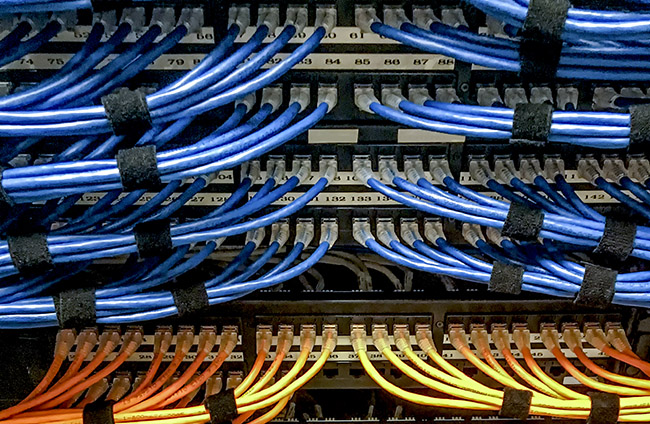
Top Web Design Trends of 2025: What Businesses Need to Know
June 2, 2025
How IoT Enhances Low-Voltage Infrastructure
June 9, 2025In today’s connected world, buildings are becoming more than just physical spaces—they are transforming into intelligent environments capable of adapting to occupant needs in real-time. At the heart of this transformation lies the powerful combination of IoT (Internet of Things) devices and low-voltage systems.
By integrating these technologies, businesses, schools, medical facilities, and government agencies can achieve more responsive, secure, and energy-efficient environments. Alpha specializes in low-voltage infrastructure and understands the critical role it plays in enabling smart building automation.
In this article, we’ll explore how IoT and low-voltage systems work together to streamline operations, reduce costs, and elevate the user experience.
What Are Low-Voltage Systems?
Low-voltage systems typically operate on 50 volts or less and are used to support non-power-intensive infrastructure in a building. These systems include:
- Structured cabling (Cat6, fiber)
- Security and surveillance (CCTV)
- Access control
- Audio/visual systems
- Fire alarms
- Building management systems (BMS)
- Wi-Fi and telecommunications networks
Unlike high-voltage electrical wiring, low-voltage systems are optimized for data transmission, communication, and control—making them the ideal foundation for integrating IoT devices.
The Rise of IoT in Smart Buildings
IoT refers to the network of physical devices—sensors, controllers, actuators, and more—that collect and share data over the internet. In a commercial or institutional setting, these devices may include:
- Occupancy sensors
- Smart thermostats
- HVAC controllers
- Automated lighting systems
- Smart locks and cameras
- Leak detection sensors
- Energy monitors
IoT enables building systems to “talk” to one another, adapt to real-time conditions, and automate processes without human intervention. But to function properly, IoT devices require a reliable, scalable low-voltage backbone. That’s where Alpha comes in.
Why Integration Matters: IoT + Low-Voltage Synergy
Combining IoT with low-voltage systems creates a unified building automation ecosystem. Here’s how the integration delivers real-world benefits:
1. Centralized Control
With IoT and low-voltage systems in sync, building managers can control HVAC, lighting, access, and security from a single dashboard. Whether on-site or remote, administrators gain full visibility into building operations and can make adjustments in real-time.
2. Energy Efficiency
Smart lighting systems with occupancy sensors automatically dim or shut off lights in unoccupied areas. HVAC systems adjust temperature based on usage patterns and environmental data. These smart features reduce utility bills and help meet sustainability goals.
3. Predictive Maintenance
IoT sensors embedded in electrical panels, HVAC units, or elevators can alert technicians to wear and tear before failure occurs. When integrated with low-voltage alarm and notification systems, this ensures proactive maintenance and minimizes downtime.
4. Enhanced Security
Low-voltage surveillance and access control systems become more intelligent with IoT integration. Facial recognition cameras, biometric access, and real-time alerts ensure only authorized personnel enter secure areas—while keeping an audit trail of all activity.
5. Scalability and Flexibility
As organizations grow or adapt to new technologies, their infrastructure must scale easily. A well-designed low-voltage system supports plug-and-play IoT expansion without major rewiring or infrastructure changes.
Real-World Applications
From schools and hospitals to office buildings and industrial warehouses, integrated IoT and low-voltage systems are creating smarter, safer spaces:
- Education: Automated bell systems, lighting, and HVAC based on class schedules.
- Healthcare: Smart patient monitoring, digital signage, and access controls for sensitive areas.
- Offices: Personalized workspace settings (lighting, temperature) that adapt to employee preferences.
- Retail: Smart shelves and inventory systems integrated with video surveillance for security and analytics.
Alpha’s Role in Smart Building Integration
At Alpha, we provide the low-voltage infrastructure necessary for successful IoT implementation. Our team designs and installs custom cabling solutions, access control systems, camera networks, and wireless connectivity platforms—all with smart building integration in mind.
We work with businesses across the Mid-Atlantic to future-proof their facilities through expert design, scalable technology, and precision execution. Whether you’re retrofitting an existing structure or designing a new space, Alpha delivers the foundation needed for intelligent automation.
Final Thoughts
The integration of IoT with low-voltage systems marks a new era in building automation. Businesses that embrace this technology gain operational efficiency, improved safety, and long-term cost savings. More importantly, they provide a better experience for the people who work in, visit, or rely on those spaces every day.
If you’re planning to modernize your facility or start a smart building project, Alpha is your trusted partner for low-voltage design and implementation. Contact us today to learn how we can help turn your building into a high-performing, connected environment.
Let me know if you want this tailored to a specific market segment (like education, healthcare, or retail) or formatted into a downloadable lead magnet or landing page content.




